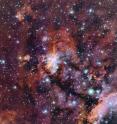Cosmic recycling
Deeply immersed in this huge stellar nursery are three clusters of hot young stars -- only a few million years old -- which glow brightly in ultraviolet light. It is the light from these stars that causes the nebula's gas clouds to glow. The radiation strips electrons from atoms -- a process known as ionisation -- and when they recombine they release energy in the form of light. Each chemical element emits light in characteristic colours and the large clouds of hydrogen in the nebula are the cause of its rich red glow. Gum 56 -- also known as IC 4628 or by its nickname, the Prawn Nebula -- is named after the Australian astronomer Colin Stanley Gum, who, in 1955, published a catalogue of H II regions. H II regions such as Gum 56 are huge, low density clouds containing a large amount of ionised hydrogen.
A large portion of the ionisation in Gum 56 is done by two O-type stars, which are hot blue-white stars, also known as blue giants because of their colour [1]. This type of star is rare in the Universe as the very large mass of blue giants means that they do not live for long. After only roughly a million years these stars will collapse in on themselves and end their lives as supernovae, as will many of the other massive stars within the nebula.
Besides the many newborn stars nestled in the nebula, this large region is still filled with enough dust and gas to create an even newer generation of stars. The regions of the nebula giving birth to new stars are visible in the image as dense clouds. The material forming these new stars includes the remains of the most massive stars from an older generation that have already ended their lives and ejected their material in violent supernova explosions. Thus the cycle of stellar life and death continues.
Given the two very unusual blue giants in this area and the prominence of the nebula at infrared and radio wavelengths, it is perhaps surprising that this region has been comparatively little studied as yet by professional astronomers. Gum 56 has a diameter of around 250 light-years, but despite its huge size it has also often been overlooked by visual observers due to its faintness, and because most of the light it emits is at wavelengths not visible to the human eye.
The nebula is at a distance of about 6000 light-years from Earth. In the sky it can be found in the constellation Scorpius (The Scorpion) where it has a projected size which is four times the size of the full Moon [2].
Source: ESO
Other sources
- The Prawn Nebula, a place where stars are bornfrom CBSNews - ScienceThu, 3 Sep 2015, 20:00:12 UTC
- La Silla Observatory images newborn stars in Prawn Nebulafrom UPIThu, 3 Sep 2015, 16:00:37 UTC
- Observatory: In the Prawn Nebula, a Nursery for Newborn Starsfrom NY Times ScienceThu, 3 Sep 2015, 11:40:08 UTC
- Prawn Nebula Photo Offers Glimpse of 'Cosmic Recycling'from MSNBC: ScienceWed, 2 Sep 2015, 19:30:28 UTC
- Cosmic recycling: Hot bright young stars born within a nebulafrom Science DailyWed, 2 Sep 2015, 14:30:37 UTC
- 'Cosmic Recycling' Seeds The Prawn Nebula | Observatory Zoom-In Videofrom Space.comWed, 2 Sep 2015, 11:30:30 UTC
- Prawn Nebula View Offers Stunning Glimpse of 'Cosmic Recycling' (Video)from Space.comWed, 2 Sep 2015, 11:30:28 UTC
- Prawn Nebula: Cosmic recyclingfrom PhysorgWed, 2 Sep 2015, 10:30:20 UTC
